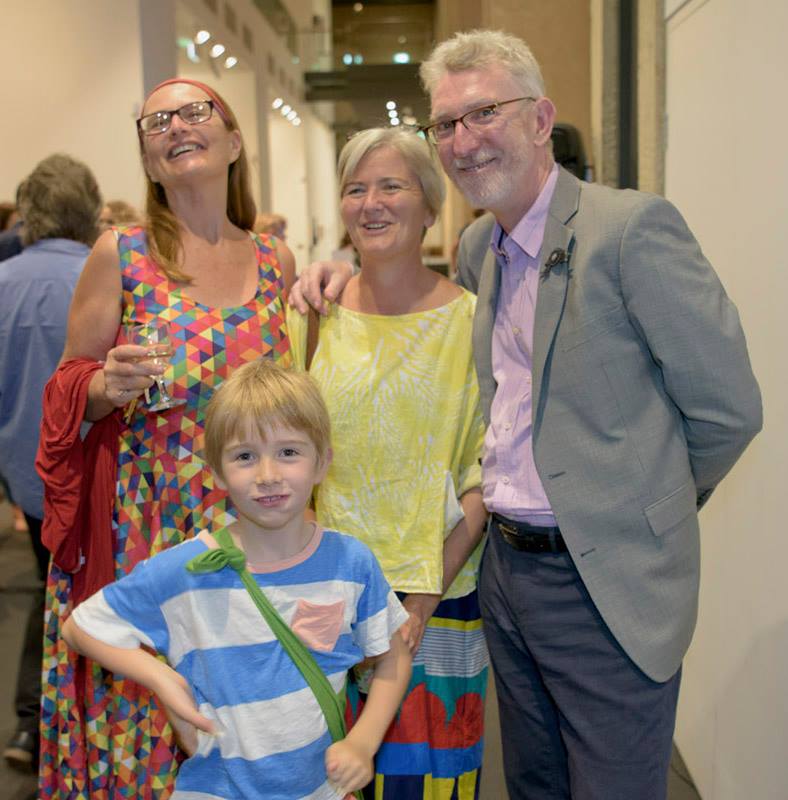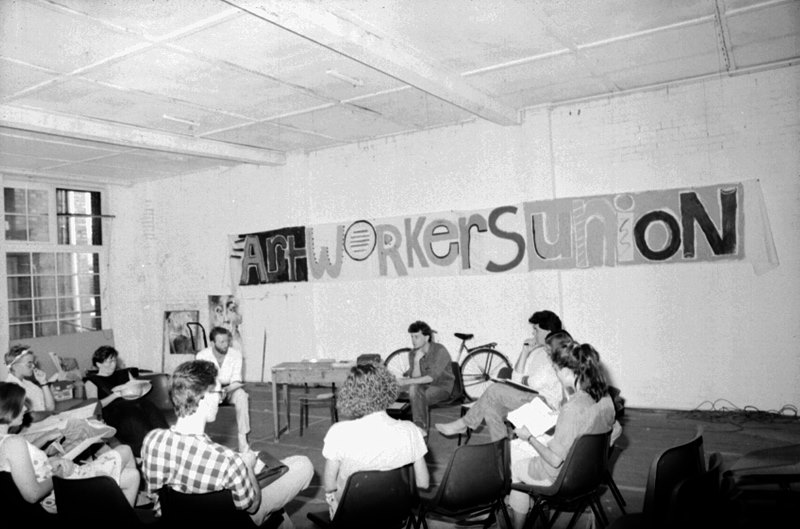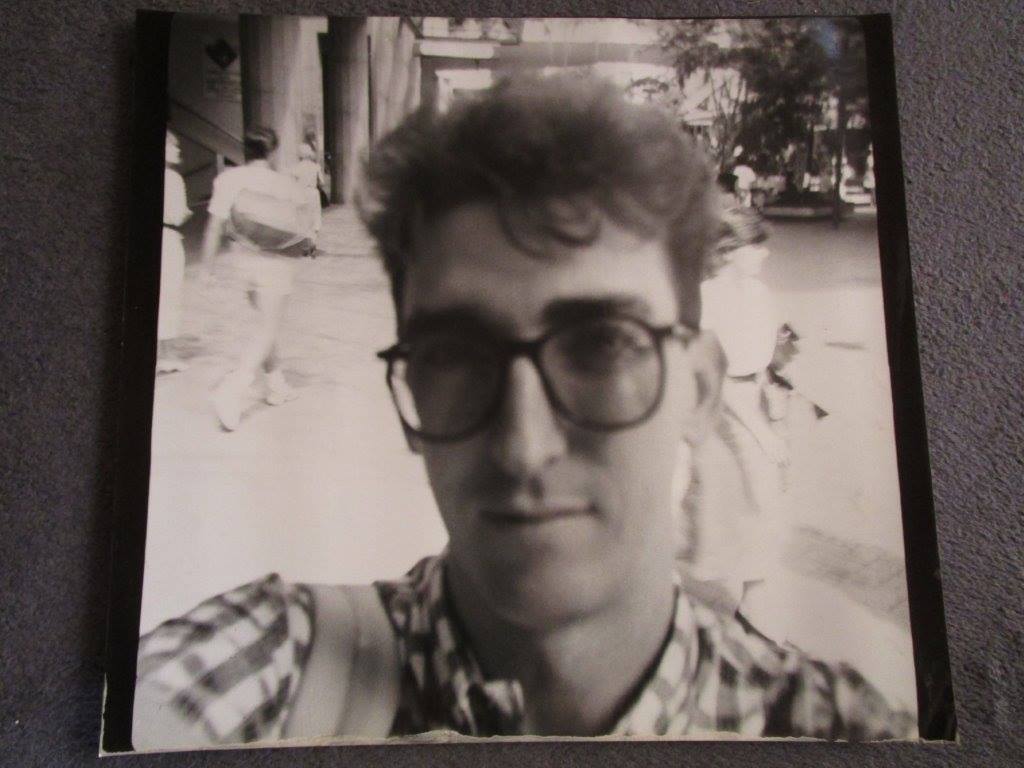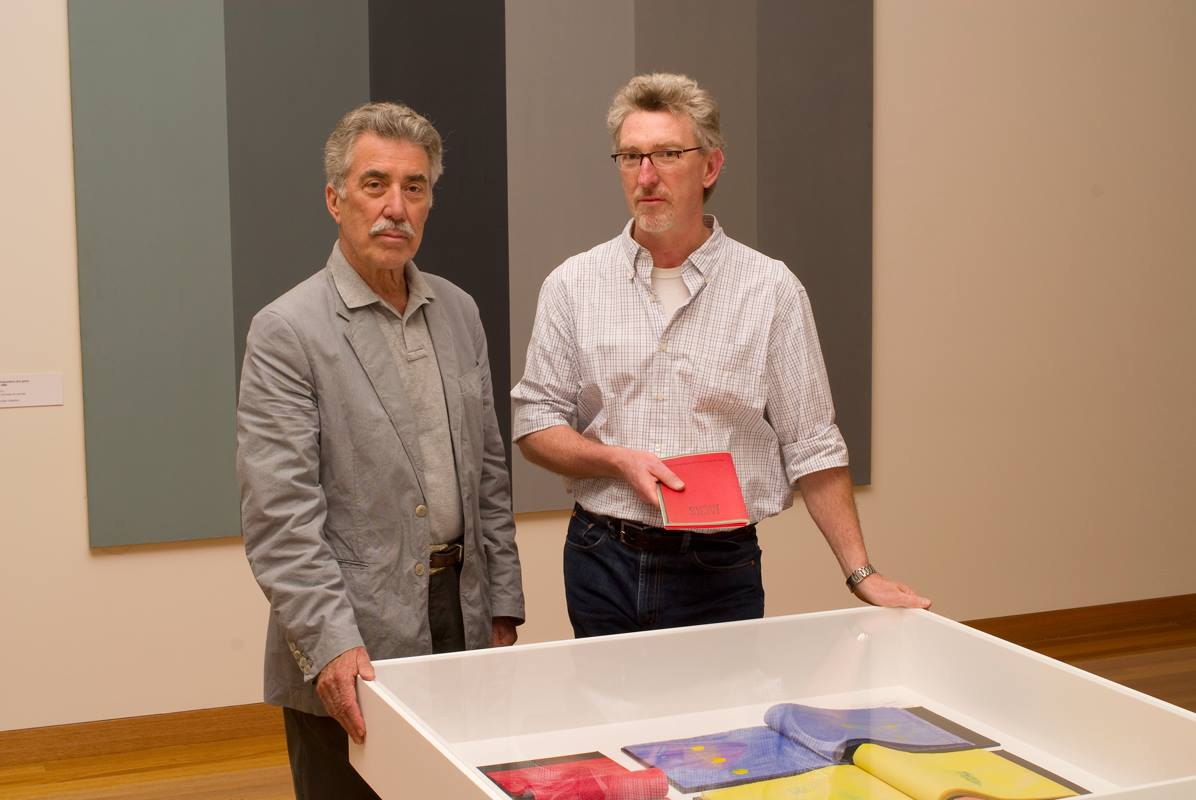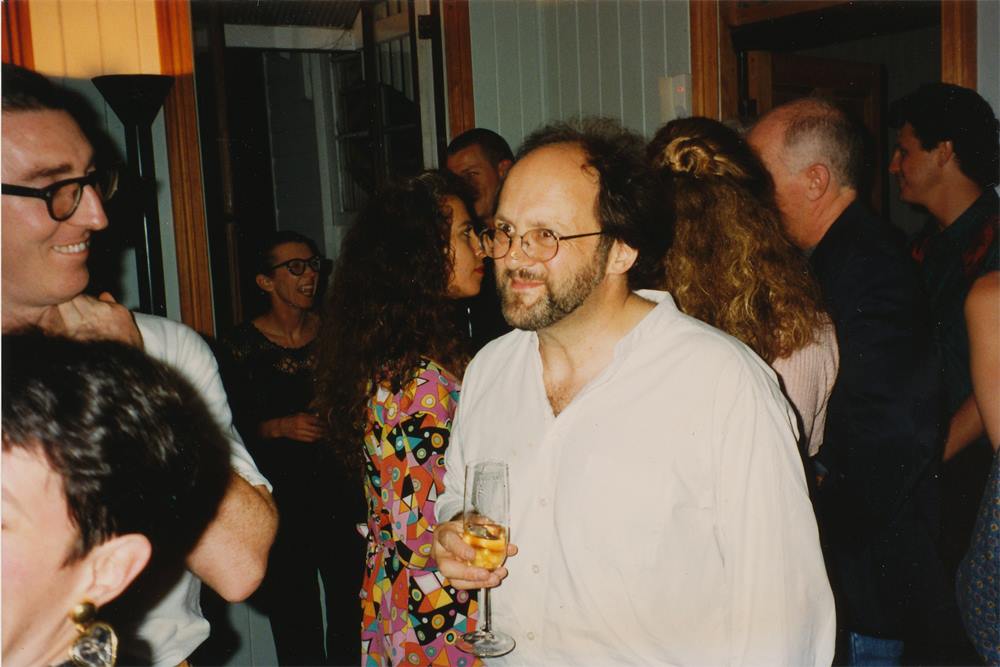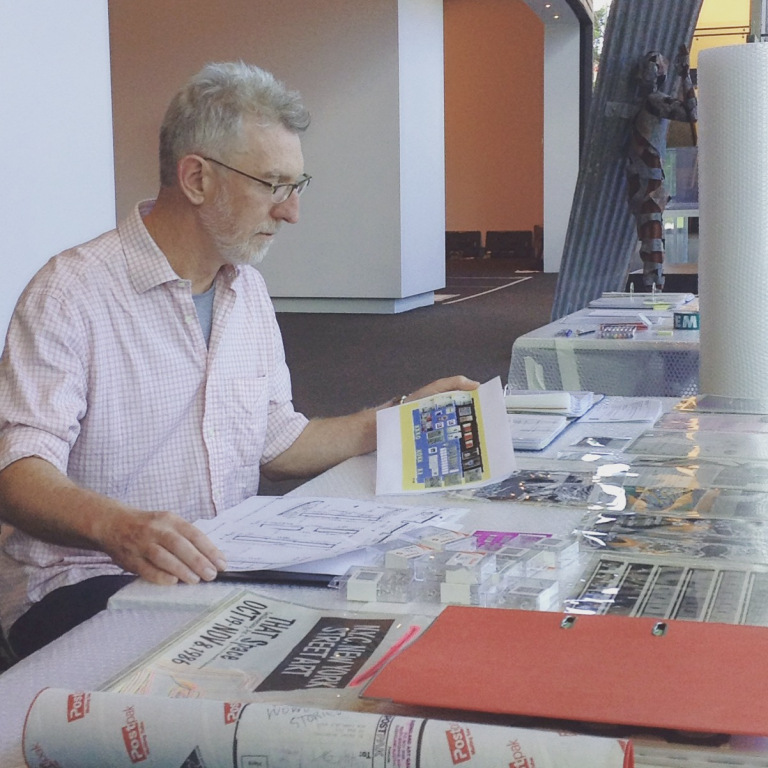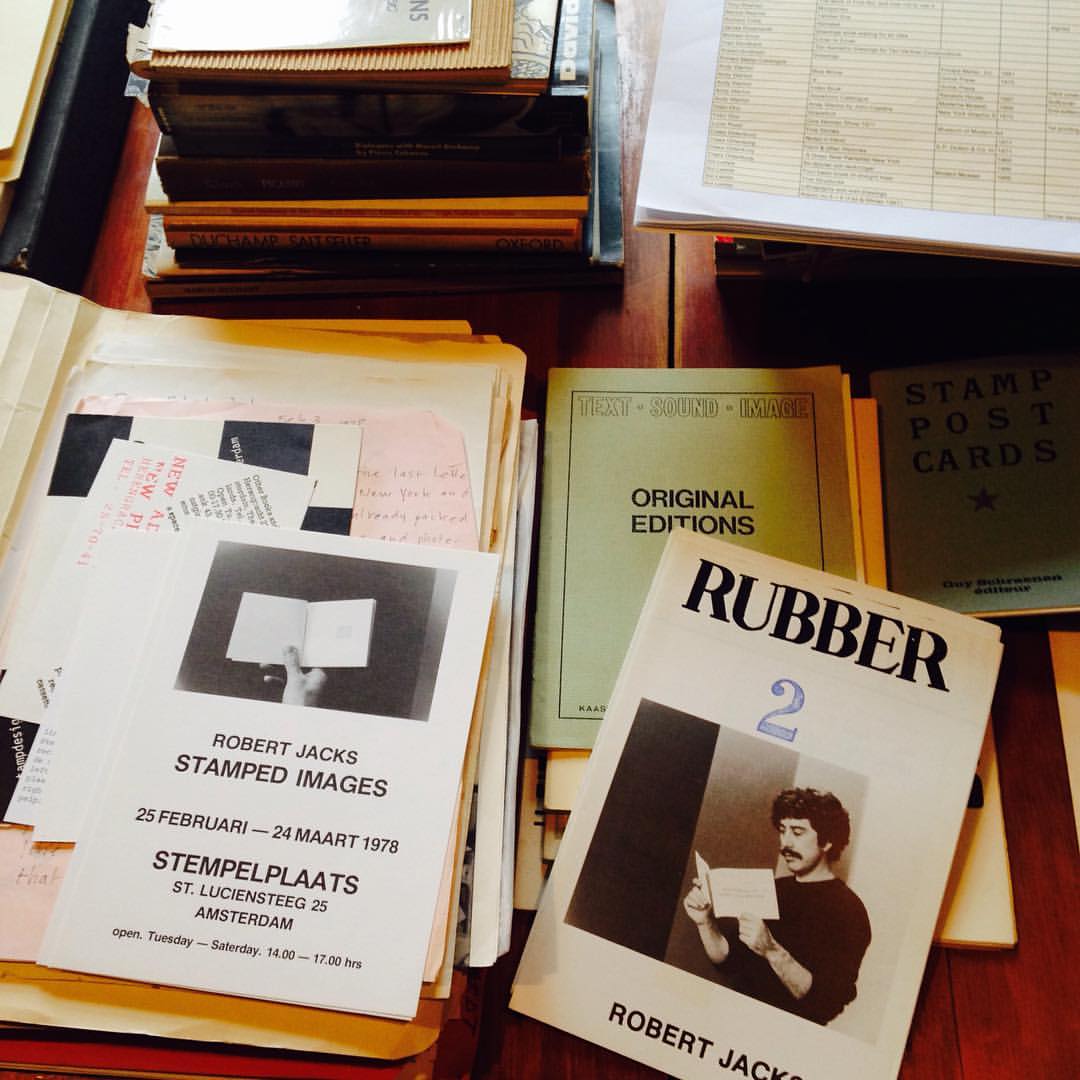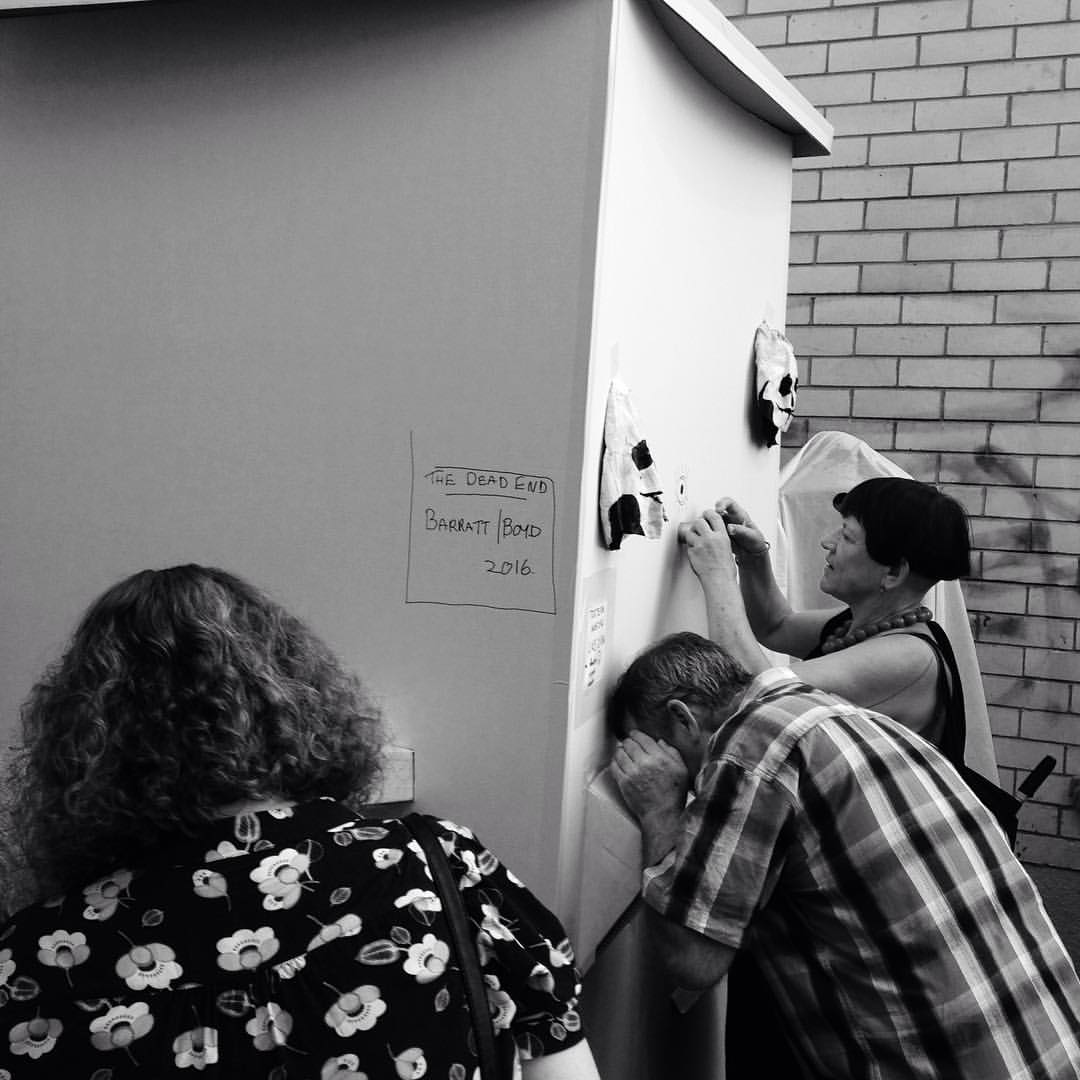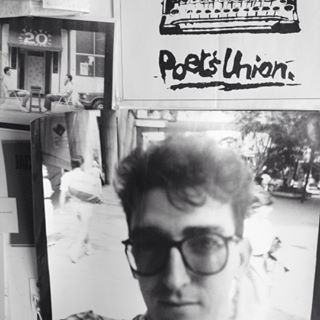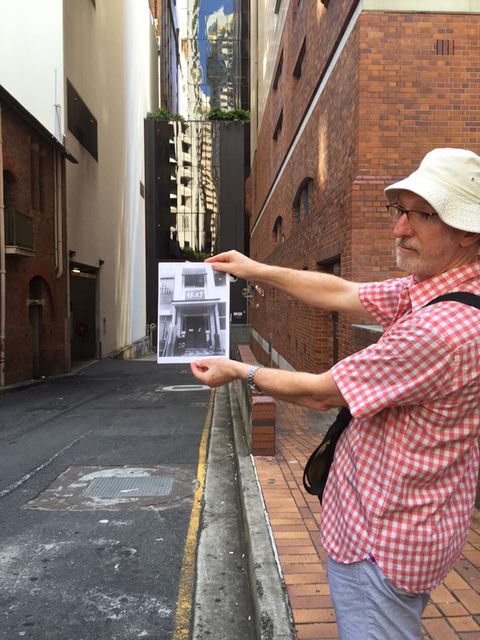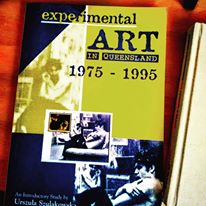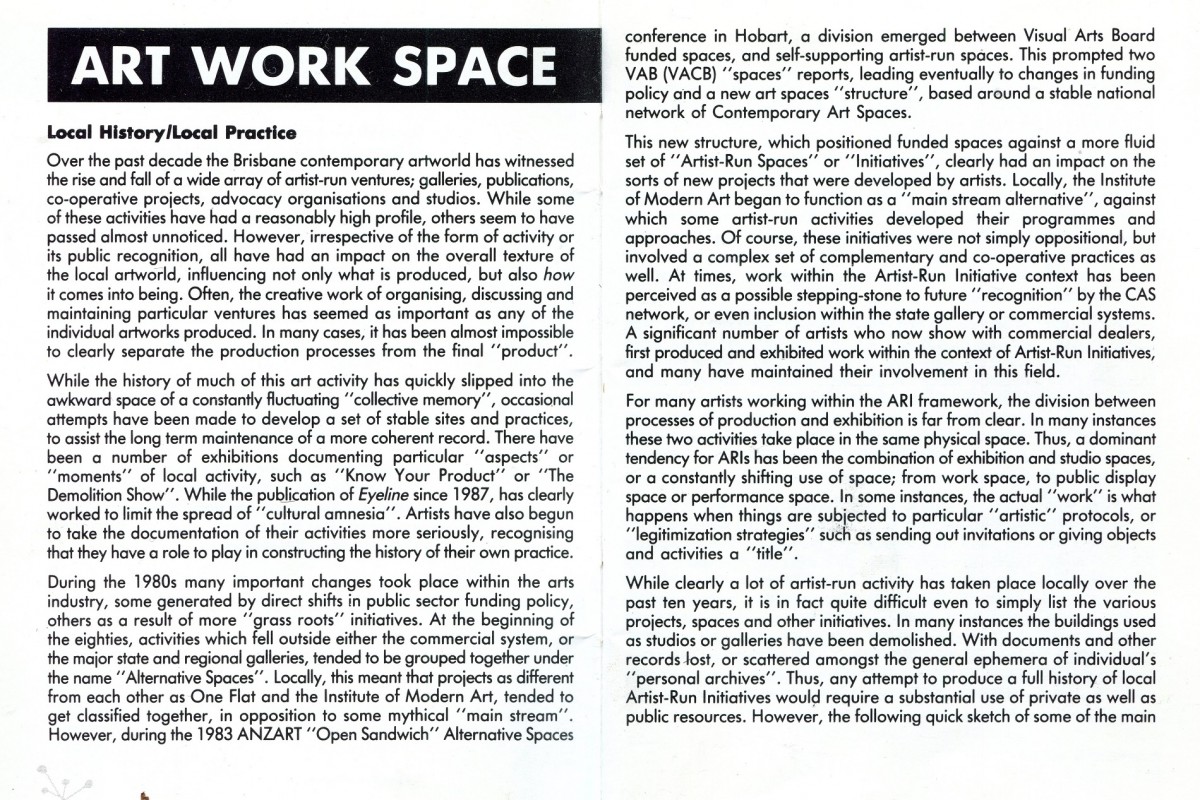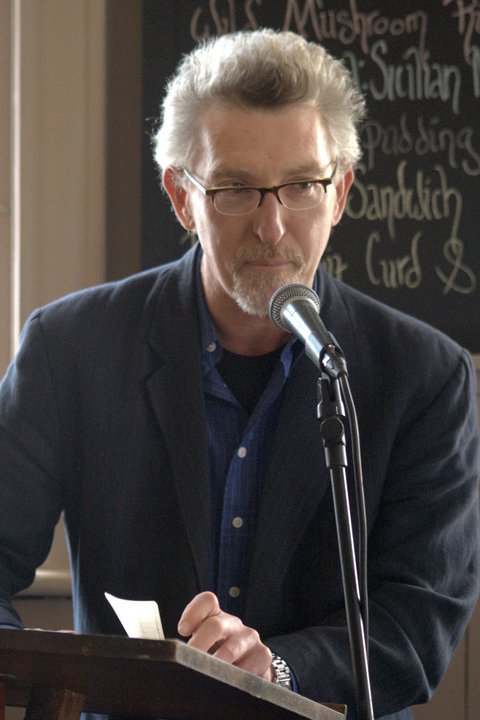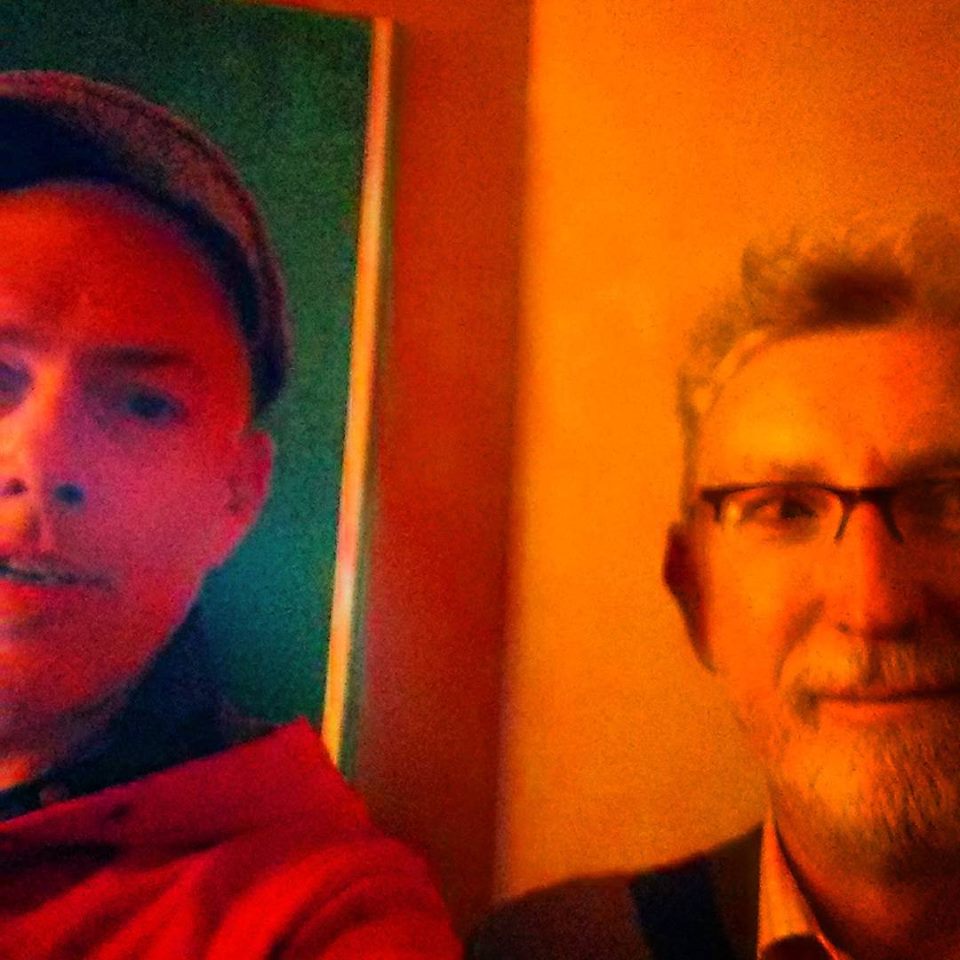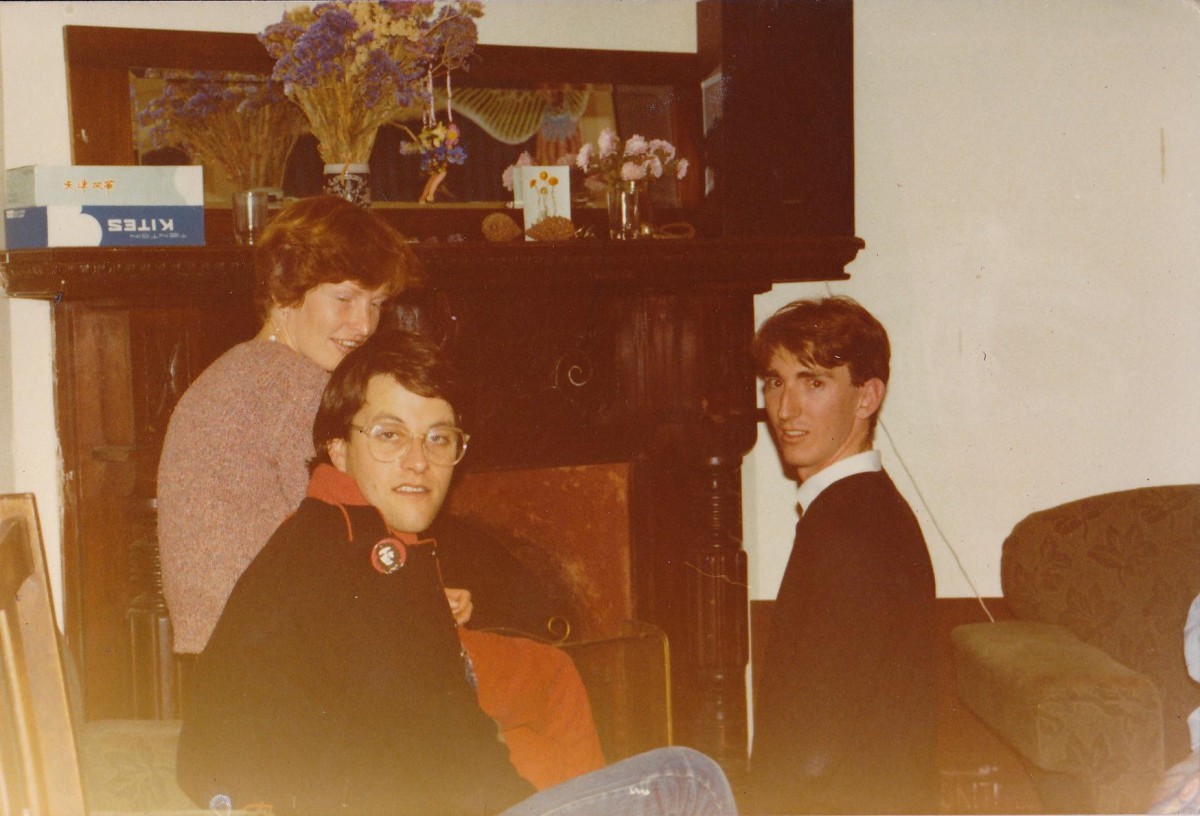Vale Peter Anderson – In memory of beloved poet, artist, songwriter, independent arts writer and curator, 2012 Inaugural Siganto Fellow – please share your personal tributes about Peter below
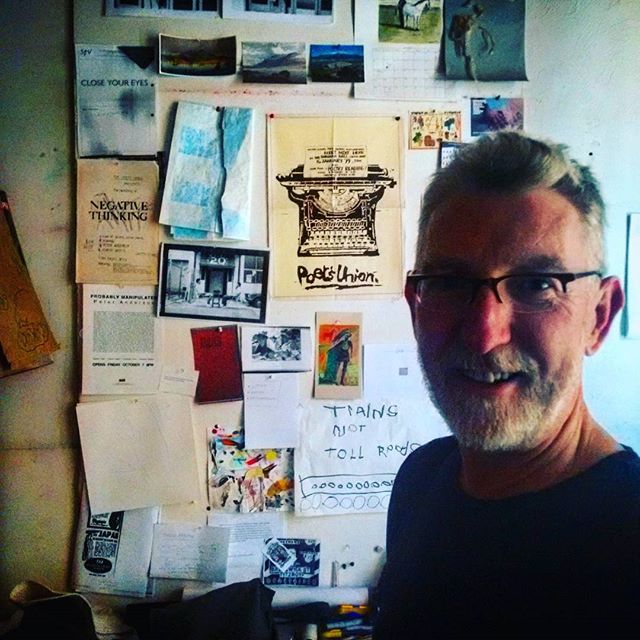
Peter Anderson with his noticeboard, Artist’s Studio, Fitzroy Melbourne 2017 Photo: Paul Andrew
PETER ANDERSON
B.14 November 1958 – D. 30 October 2020
Sadly poet, songwriter, visual artist, independent arts writer and curator writer and beloved friend Peter Anderson has died in Fitzroy Melbourne. Peter passed instantly from natural causes while doing something he was most passionate about, swimming. He was aged 61 years.
From an arts perspective, Peter was a strident voice and change agent involved in the Australian independent arts sector for over 40 years. Arguably it was Peter’s passion, enthusiasm and labour as an activist and performance poet involved in building and growing the Poets Union with poet Robert Whyte and many other Brisbane D.I.Y creatives in 1977 which was foundational to his artistic life, both personally and professionally.
In a community meeting of Brisbane-based artists held at the John Mills Himself Building in early 1985 convened by artist activist Brian Doherty and the Artworker’s Union Queensland Peter spoke eloquently and urgently about both the Poets Union Queensland and the Artworkers Union Queensland as vital collective organisational models with added potential for new artist organisations. In particular he argued for the need for a more explicit, grassroots and member-based local arts advocacy and lobby group and of the urgency for a local arts magazine to address a gap in the canon about Queensland’s rich and emergent contemporary art, design, media culture.
In 1986 the Artworker’s Union Queensland was dissolved by a consensus vote and the Queensland Artworker’s Alliance was formed. Key initial challenges for the QAA constituted at a public meeting held at the then Brisbane Community Arts Centre located at 106 Edward Street Brisbane City (now Metro Arts) where Peter alongside a cohort of artworkers were instrumental in establishing a framework for artists’ moral rights, artist agreements, artists fees and copyright acknowledgements. A ‘Q’ magazine collective was also formed at the time to actively address the gap of arts publishing in Queensland and these groups included a diverse and overlapping range of artworkers’ voices.
Peter was involved in pivotal ways including discussions towards the early ‘guest-editor’ model proposed for ‘Q’. In 1986 Eyeline Contemporary Art Magazine was formed with Sarah Follent as the magazine’s dynamo executive editor for over thirty years. The Queensland Artworkers Alliance [QAA] continued to operate and play a vital and effective grassroots role in the visual arts sector both in Queensland and nation-wide until 2011.
As a regular and ongoing contributor to Eyeline and to many Australian and International art magazines and journals up until his recent death Peter’s key themes included arts policy, arts advocacy, essays about exhibitions and artist-run culture, art reviews and creative writing. Peter is also well known as a scribe who worked tirelessly and affectively in close collaboration with artists. In many ways he was an unrelenting amanuensis for friends, colleagues and strangers alike. Peter enabled independent artists’ voices intentions, feelings and concepts to be heard and documented as strong narratives in the independent media and publishing sectors .
As a recent contributor to Permanent Recession: a Handbook on Art, Labour and Circumstance in 2019 edited by Channon Goodwin, Peter’s essays provide a detailed insight into this sector which adds to a rich continuum of debate about the Australian artmaking context.
Peter carefully maintained a life-long interest in and a collector of independent artist publishing, artist books , zines and artists ephemera and was awarded the 2012 Inaugural Siganto Fellowship at the State Library of Queensland. The fellowship provided him with an extraordinary opportunity to research their collection for documentary evidence about Brisbane’s ever proliferating artist-run culture stemming back to artist co-operatives in Brisbane during the 1940s including the Barjai and Miya Studios artists.
He is well known for extensive research and curatorial work with artist Robert Jacks AO who was an Australian painter, sculptor and printmaker. ( b.8 March 1943 – d. 14 August 2014) and as the intrepid curator of the Ephemeral Traces exhibition held at the University of Queensland Art Museum in 2016. These two overlapping curatorial investigations form a rich vein of artist inquiry that forms a cogent base for Peter’s doctoral research during the past six years.
Ephemeral Traces was an important introductory survey of Brisbane’s then emergent “artist-run spaces scene” which unfolded throughout the late 1970s and the 1980s. The survey exhibition was a vast collaborative effort and focused on five Brisbane artist-run spaces; operating between 1982 and 1988; the One Flat group, A Room, The Observatory collective, That Contemporary Art Space collective and John Mills National . It comprised a series of lively participatory events, re-iterative performance walks and an artists’ picnic. This event collaboration with many artists and artworkers; past, present and emerging, forms a small and important aspect of a now oceanic independent D.I.Y artist-run ecology which continues to be slowly documented as a vibrant experimental and collectivising force in today’s contemporary art worlds.
From a personal perspective, while collaborating with Peter on the research for this exhibition and for four years afterwards Peter often wrote to me with vignettes about some of the many forgotten aspects of his own vibrant and largely undocumented life as a poet and visual artist. In a personal email to me on the 2nd of August 2017 Peter wrote;
“The death of Sam Shepard this week sent me into another reverie – back in 1977 (August 77, so 40 years ago) I had a part in a production of Shepard’s play “The Unseen Hand” which was done as a ‘late show’ at La Boite. It was at that moment that I slipped out of the schedule of broadcasting on 4ZZZ (after what seemed like a long time, but was only 12 months on-air) – due to rehearsals and the production (which ran late Aug into the first days of Sept). That was also about the time that I published my first poems (in retrospect, they were not that good). After the play’s run I began working at QIT as a cleaner and in October was arrested in a street march … by late in the year I was doing the ‘street texts’ at the University of Queensland and around Brisbane city. In November that year I also moved out of home into a share house – so it was a time of much activity and a lot of change (I turned 19 in mid-November 77). I’d taken a year off from Griffith from mid-77 to mid-78 … and put most of my time into poetry. By mid-78 I was making the move to get the Poets Union going & was working with Robert Whyte in a very collaborative way … the Poets Union, which produced Negative Thinking (launched 5 October 1978) … so I was still 19. The move to Hobart came in early 1979, before Uni. started. Pretty quickly I got involved in the Creative Action Collective / Freize Collective – poetry publishing/ performances/ a radio show/ and exhibition activity (while working as a cleaner, life model, kitchen hand, teacher’s aide, script writer for the ABC. I spent no time on the dole at all right through these years … my ‘slim volume’ ‘Pretending to be Salvador Dali’ came out through Makar Press (UQ based poetry publisher) in the second half of 1979 (while I was in Hobart & still 20, and on count back it turns out that I was the youngest poet they ever published – they did about 37 slim volumes over the years between 72 and 79 … mine was N0.35).
I remember meeting beautiful Peter in October 1984 at an earlier community meeting of experimental artists held at the Institute of Modern Art then located in Edward Street, Brisbane City and convened by then artist director and a most ardent supporter of instigating artist-run culture in Brisbane, Peter Cripps. This event was organised to bring together many artists who were working independently but who were feeling isolated and were keen to collectivise and start-up a more explicit type of artist-run space culture together.
Peter Anderson provided a litany of practical advice, important tips, strategies and suggestions to everyone who attended, based on his own extensive experiences with the Poets Union, with Brisbane bands, various collectives and as an artist and performance poet working across performing arts, literature, community media, publishing and visual arts. Peter’s expertise throughout this period also drew from his experiences as a student at the then newly opened Griffith University sector years with a sharp focus on arts, film, drama and media studies. We have remained dearest friends ever since.
While many of this year’s fervent [as ever] discussions at home in March in the pre-covid climate and on the phone were about Peter feeling absolutely thrilled to bits that he was nearing the completion of his doctoral research, in a recent email Peter explained his reflective practitioner’s journey in this way;
“The whole PhD is structured in a way that shuffles between fiction / non-fiction … as I see it, the PhD is an academic Creative Writing project … that’s the ‘readership’ or ‘the market’ for the work. Although some bits of it also have other contexts & a life outside the PhD. Like any PhD is what you might call a ‘demonstration of my capacity to function as a researcher within the discipline’.
These pithy conversations about higher degree research always began with candid cascading stories about his family, their many trips away from Fitzroy and into fecund parts of regional Victoria with his beloved wife Jennifer Bartholomew and son Benjamin Bartholomew-Anderson, and vivid accounts of being in nature together, long walks, diving into waterfalls, following tide lines timelessly, collecting seaweed and earthy objet trouves, making ephemeral artworks from flotsam and jetsam, priceless moments of joy.
Peter lived each day passionately, was an immensely generous, erudite, intellectual, creative, practical, good-humoured, fit and humble man. Levity was a distinctive quality in Peter that has always kept me and many others feeling buoyant and light with a knowledge that things will improve even at times like this when things feel grim and dire.
In the past few days since learning of Peter’s sudden death, my own reveries are unfolding while sifting through ten thousand vivid remembered memories of Peter, his family, friends and colleagues. Today I recalled a small and meaningful aspect of Peter’s life as a songwriter that I continue to hold dear to my heart.
As family, friends and colleagues know well Peter was passionate and enthusiastic about everything and anything that took his fancy and perhaps, more often than not, his sheer delight in the fancy of creative comrades in kinship murmuring around him. Peter is not often discussed as being part of the “Brisbane Sound” of the 1980s that included a creative critical mass who today also remain unsung. It was a subject of his early life that Peter loved to wax and wane about when in the company of fellow noise makers, musicians and like-minded people. People who spoke music, had noise, music and musicality in their bloodstream. It was something Peter recalled in an unpublished interview together with musician Ian Wadley at Ian’s home in Melbourne in 2015. And more recently in the reflective email from 2017 when Peter continues,
“ Looking back now, I think I failed to capitalise on the opportunities, something that was exacerbated by the moves back and forth between Brisbane & Hobart. 1980 in Brisbane was good, I had a better paid cleaning supervisor’s job (6 am to 10:30 am daily), plus script work at the ABC, and of course all the interviews for the IMA, as well as a band that wanted my songs, including the songs Tightrope and Great Wall of China & was actually reasonably successful – here in this appearance on a local TV show – (https://www.youtube.com/watch?v=Ct_D6EQuiwo).
Peter Anderson’s many elegant and antagonistic murmurations; both known and unknown, published and unpublished have made and will continue to make an important contribution to knowledge, and like all murmurations will reverberate throughout living memory ahead.
This video clip is included here in a brief personal memory tribute below for your enjoyment. Special thanks to Brisbane band Perfect Strangers for kindly sharing this clip as it appeared on TV in the early 1980s on You Tube for all to experience. With Mark Dadds on guitar + vocals, Tony Childs on bass, and John Downie, from JFK and the Cuban Crisis, “pretending to play drums because the usual drummer David Chambers was lost in the carpark during filming. The song Tightrope written by Peter Anderson and Mark Dadds.”
Thanks everyone who have so kindly and caringly reached out in the wake of the shocking news We can grow this humble tribute page for Peter over time with commentaries, memories, photos and images and bits’ n ’ pieces, flotsam and jetsam to remember the friendship extended and the small and significant contributions to knowledge that Peter has made throughout his life in Australia and overseas.
Kindly add your memories and tributes here below this cascading photo essay tribute in the commentaries thread below this vignette.
Paul Andrew
Artist, D.I.Y Coordinator, ARI Remix Project
Selected Links
https://soundcloud.com/uqartmuseum/trace-of-the-past-why-collecting-and-exhibiting-ephemera-is-important?
http://independent.academia.edu/PeterAnderson28/CurriculumVitae
https://ariremix.com.au/interview-robert-whyte-on-the-artist-run-impulse
https://www.slq.qld.gov.au/discover/exhibitions/past-exhibitions/siganto-fondation-artists-book-project/discover-siganto
https://allconference.org.au/library/ephemeral-traces-brisbanes-artist-run-scene-in-the-1980s
Featured Photo: Opening night, Ephemeral Traces, (l-r) Hollie, Jen Bartholomew, Peter Anderson and Ben Bartholomew-Anderson 2016. Photo: Courtesy UQAM archives, St Lucia.

